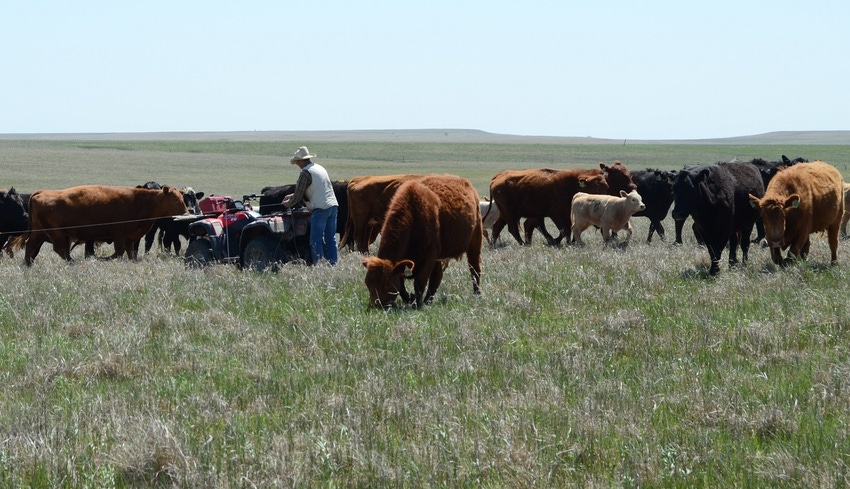
There is a productive, practical and profitable way to reverse many of the maladies affecting conventional ranching: It is holistically planned high-stock-density grazing.
The difference between this process and "grazing systems" of all sorts is profound. The defining differentiation is the term holistic. In this context it means inclusive of all factors, such that all parts of the soil-plant-animal-wealth-human complex we call a ranch are included in the planning and that the needs and abilities of all of these elements are considered.
This sort of grazing and the management thereof that is planned, implemented, monitored, and when necessary re-planned will meet the requirements of all aspects of the operation. The wellbeing of the animals, the plants, the soil, the finances, and the people must all be addressed in the plan.
For example, the varying nutritional needs of different classes of grazing animals will be addressed by determining when and to what degree a given forage sward will grazed by which class. Young, growing animals need more protein than do older animals while lactating or fattening animals need less protein and more energy. Since the quality factors (protein and energy contents and digestibility) vary with plant species, stage of maturity and degree of defoliation, matching supply and demand of nutrients requires thought and planning. This sounds harder than it is in practice.
We are dealing with a set of relationships between grasslands and grazing animals that have been in existence and proven their value over many thousands of years. Grasslands, grassland soils and grazing animals evolved together and developed under a set of mutually beneficial relationships. Conditions change and either the affected plants, animals and microbes adapt to the new conditions or they are replaced by species that are adapted.
Humans were late comers to this ecological system and as their numbers and abilities increased so did their effects on the system. Almost universally these effects were harmful but that does not need to be the case. Through the ability to reason, humans can be valuable participants. They can take subsistence (wealth) and at the same time improve conditions for the entire system. The first criterion for this management should be, first do no harm.
Anything that causes serious damage to any part of the system damages the entire system. Modern man has largely seen the grasslands as something to subjugate. The Homestead Act requiring that the land must be plowed and "made productive" is evidence of this mindset. Distain for grasslands has been and still is widespread. It was not until the country was ravaged by the Dust Bowl of the 1930s that the value of grasslands to the US began to be recognized.
However, there is still a lot of misunderstanding as to how grasslands and grazing animals interact. While grasslands have been and still are being damaged by improper grazing, proper grazing is the most powerful tool available to restore grasslands to health. Proper grazing is not rocket science but its implementation requires thought and planning. Failure is guaranteed if any of the members of the complex – soil-plants-animals-wealth-humans – are not included in the planning and implementation of the plan.
When grazing animals are concentrated on an area of forage that is in advanced growth stage II, which is boot stage or slightly beyond, for a short period of time and then moved to fresh pasture, leaving at least 50-60% of the forage behind, not to return until the forage has completely recovered from the effects of grazing, some very good things begin to happen.
This works best with a dense stand of forage, and that comes with the improvements. Soil health improves dramatically, as does plant growth. The animals do well, as they are constantly moving to fresh pasture with a lot of forage on offer and can select their diet from a clean plate.
The short graze periods assure that there are no radical changes of diet so rumen microbial populations flourish and stabilize and animals do not suffer metabolic upsets due to diet being wrong for the current population of digesting microbes. The short graze periods allow the grazier control of several important things: Forage growth stage at harvest, degree of forage utilization, and even population size of animal pathogens and parasites.
Recovery periods determined by growing conditions and forage-growth habits promote healthy forage swards. Forage growth increases dramatically due to soil improvement and to the large amount of functioning leaf left on the plants. Grazing in this manner promotes healthy plants, healthy soil and healthy animals. It is also good for bank accounts and nervous stomachs in ranchers.
The longer an area is under this type management, the more productive of life of all kinds and the more resilient it becomes when bad weather or other poor growing conditions occur. The areas managed in this way will appear, in comparison to neighboring areas, to be "drought proof."
If a large enough area is improved, the amount of local precipitation will increase due to higher humidity in the local atmosphere. The principles controlling this phenomenon are the same as the more widely recognized "lake effect" where large bodies of water increase local precipitation. The reverse situation, large areas poorly managed, will see a reduction of local atmospheric humidity and precipitation. Many areas of the world are seeing large swaths of land turn to desert because of poor capture and utilization of rainfall and the resulting loss of water to the local water cycle. Proper grazing offers the only practical way to bring about the conditions needed to reverse desertification.
About the Author(s)
You May Also Like




